
Tulsa is the second-largest city in the state of Oklahoma. It has many diverse neighborhoods due to its size.

Sugar Hill is a National Historic District in the Harlem and Hamilton Heights neighborhoods of Manhattan, New York City, bounded by West 155th Street to the north, West 145th Street to the south, Edgecombe Avenue to the east, and Amsterdam Avenue to the west. The equivalent New York City Historic Districts are:

Hillcrest Historic District is a historic neighborhood in Little Rock, Arkansas that was listed on the National Register of Historic Places on December 18, 1990. It is often referred to as Hillcrest by the people who live there, although the district's boundaries actually encompass several neighborhood additions that were once part of the incorporated town of Pulaski Heights. The town of Pulaski Heights was annexed to the city of Little Rock in 1916. The Hillcrest Residents Association uses the tagline "Heart of Little Rock" because the area is located almost directly in the center of the city and was the first street car suburb in Little Rock and among the first of neighborhoods in Arkansas.

Glenville Historic District, also known as Sherwood's Bridge, is a 33.9 acres (13.7 ha) historic district in the Glenville neighborhood of the town of Greenwich, Connecticut. It is the "most comprehensive example of a New England mill village within the Town of Greenwich". It "is also historically significant as one of the town's major staging areas of immigrants, predominantly Irish in the 19th century and Polish in the 20th century" and remains "the primary settlement of Poles in the town". Further, "[t]he district is architecturally significant because it contains two elaborate examples of mill construction, designed in the Romanesque Revival and a transitional Stick-style/Queen Anne; an excellent example of a Georgian Revival school; and notable examples of domestic and commercial architecture, including a Queen Anne mansion and an Italianate store building."

Rosedale Park is a historic district located in Detroit, Michigan. It is roughly bounded by Lyndon, Outer Drive, Grand River Avenue, Southfield Freeway, Glastonbury Avenue, Lyndon Street and Westwood Drive. It was listed on the National Register of Historic Places in 2006. The Rosedale Park district has the largest number of individual properties of any district nominated to the National Register of Historic Places in Michigan, with 1533.

The Stroud House is a historic house at SE F Street and East Central Avenue in Bentonville, Arkansas. It is a 1 1⁄2-story wood-frame structure, with asymmetrical massing and decorative shinglework typical of the Queen Anne style, and a shed-roof front porch supported by Colonial Revival columns. It is a high-quality local example of this transitional style of architecture, built in 1903 by Daniel Boone Laine and Delila Laine. The property also includes remnants of a 1925 gas station.

The Governor's Mansion Historic District is a historic district covering a large historic neighborhood of Little Rock, Arkansas. It was listed on the National Register of Historic Places in 1978 and its borders were increased in 1988 and again in 2002. The district is notable for the large number of well-preserved late 19th and early 20th-century houses, and includes a major cross-section of residential architecture designed by the noted Little Rock architect Charles L. Thompson. It is the oldest city neighborhood to retain its residential character.

The Rainsford Historic District in Cheyenne, Wyoming comprises a group of Victorian houses, many designed by architect George D. Rainsford. The neighborhood includes the residences of a number of cattle barons, giving rise to the name "Cattle Baron Row." The district is located immediately to the east of downtown Cheyenne and includes examples of Stick, Eastlake, Greek Revival, Romanesque Revival and Shingle style architecture, among other eclectic styles of the time. The neighborhood includes the former Wyoming Governor's Mansion and the William Sturgis House, both individually listed on the National Register of Historic Places.

The Bailey House is a historic house at 302 Chestnut Street in Warren, Arkansas. The 2 1⁄2 story Victorian house is one of the most elaborately styled houses in Bradley County. It was built around the turn of the 20th century by James Monroe Bailey, an American Civil War veteran and a local druggist. The house he built originally occupied an entire city block near the Bradley County Courthouse; the estate has since been reduced to just the house. Its dominant features are an octagonal cupola and a two-story porch with delicate turned balusters and bargeboard decoration.

The Maysville Historic District is a historic district in Mobile, Alabama. The district covers 451 acres (183 ha) and contains 1121 properties located southwest of downtown and directly south of the Leinkauf Historic District. Platted in 1871 in the midst of a recession in Mobile, the neighborhood did not begin to develop until the late 1890s. Maysville has long been a working class neighborhood; many late 1890s and early 1900s houses were bungalows and cottages, some with modest Victorian influences. Some larger and more decorated houses were built in the northeastern portion of the neighborhood. In the early 20th century and into World War I and World War II, the Port of Mobile and its shipyards became a focus of Mobile's economy, and the population grew in response. The early 20th century saw many craftsman-style bungalows and four square houses built. Minimalist Traditional and some ranch-style houses became popular around and after World War II. Notable contributing buildings in the district are Ladd–Peebles Stadium, built in 1948, and Williamson High School, built in 1965. The district was listed on the National Register of Historic Places in 2013.

The Routh-Bailey House is a historic house on Old Wire Road in Fayetteville, Arkansas. It is a two-story brick I-house with Greek Revival styling. Completed about 1850, it is rare within the state as a surviving antebellum brick farmhouse. It was built by Benjamin Routh on land granted to him in 1848 by President Zachary Taylor. When it was listed on the National Register of Historic Places in 1989 it was described as being in deteriorated condition. It is located east of Arkansas Highway 265, northwest of a north-to-east bend in Old Wire Road.
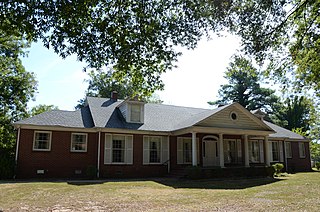
The Collison House is a historic house at 260 North Main Street in Bald Knob, Arkansas. It is a 1-1/2 story brick structure, with a side gable roof. It is a traditional linear ranch house with Colonial Revival features, including its main entry, which has sidelight windows and a fanlight above. The house was designed by Estes W. Mann and built in 1950 for Mrs. June Collison. The house is notable as one of the first ranch houses to be built in its neighborhood.

The School Addition Historic District encompasses a middle-class residential area of Batesville, Arkansas that typifies its growth between about 1850 and 1950. It is located between Main Street and Poke Bayou, along two blocks each of Rock and Water Streets, and the intervening blocks of 7th and 8th Streets. Houses in this area are generally of a modest scale, built for tradesmen and craftsmen. They come in a variety of styles, including the traditional I-house, American Craftsman-style bungalows, and ranches. The district was platted out in 1849 and sold off by the town to raise funds for public education.

The Whittington Park Historic District encompasses a mainly residential area in northwestern Hot Springs, Arkansas. The district is centered on Whittington Park, a landscaped design of Frederick Law Olmsted built in the 1890s by the National Park Service. The park is lined to the north and south by a neighborhood built out in two phases, 1920–40 and 1950-1960s. These building periods are represented by a significant number of modest Craftsman and Ranch-style houses, built primarily for people of modest means. There are also several Queen Anne Victorians in the area, the most notable of which stands at 524 Whittington.
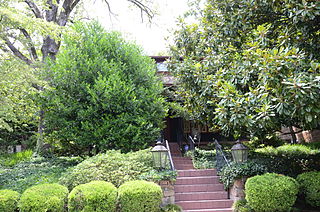
The Mims-Breedlove-Priest-Weatherton House is a historic house at 2108 Beechwood Avenue in the Country Club Heights neighborhood of Little Rock, Arkansas. It is a 1 1⁄2-story wood-frame structure, finished in the Craftsman style. It has a side-gable roof with a shed-roof dormer, extending over its front porch, which is supported by square cypress box columns. Elements of the house framing are timbers salvaged from the demolition of the Gus Blass dry goods store. It was built about 1910 by H.T. Mims, supposedly as a wedding present for one of his twin daughters. Houses of this sort were once typical in the neighborhood, which has seen many torn down and replaced with larger, more modern residences.

The Hendrix College Addition Neighborhood Historic District encompasses a predominantly residential area of Conway, Arkansas that was developed in the first half of the 20th century. Located just north of the Hendrix College campus, it is an area of about 40 acres (16 ha) and twelve square blocks, bounded on the south by Winfield Street, the west by Washington Avenue, the east by Harkrider Street, and the north by Fleming Street. Architecturally, the houses in the neighborhood represent a cross-section of styles popular in the period, from the Prairie School and English Revival, to post-World War II ranch houses. The land had been acquired by Hendrix College when it relocated to Conway in the 1890s, and was developed as a way to pay off some of the debts incurred because of the move. It was one of the city's first formally platted subdivisions.
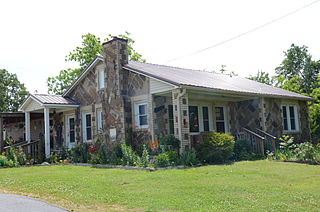
The Farris and Evelyn Langley House is a historic house at 12 Langley Lane in Republican, Arkansas. It is a rectangular frame house, its exterior finished in stone veneer with cream-colored brick trim. A gabled roof covers the house, extending over a recessed entry porch, its corner supported by a brick post. The ranch-style house was built in 1956 by Silas Owens, Sr., a mason noted regionally for his distinctive style. Hallmarks of his style are evident in this house, including the cream brick, and angled placement of the stones on the building's larger surfaces.
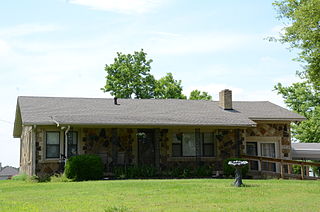
The Washburn House is a historic house at 40 Battles Loop in Guy, Arkansas. It is a single story Ranch style house with a gabled roof. It has wood frame construction, but is finished in sandstone veneer with cream-colored brick trim, hallmarks of the construction style of a noted regional African-American mason, Silas Owens Sr., who built this house in 1953. It features quoined brick surrounds for the doors and windows and a front porch whose roof is an extension of the main roof, with wrought iron posts.
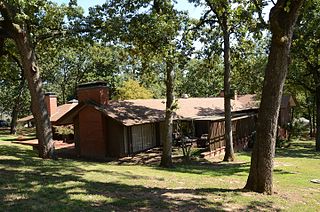
The Oscar Chamber House is a historic house at 3200 South Dallas Street in Fort Smith, Arkansas. Built in 1963-64 to a design by Arkansas architect Ernie Jacks, it is a prominent local example of residential Mid-Century Modern architecture, set in a neighborhood of more conventional ranch and split entry houses. It is a single-story frame structure, with a broad gabled roof, vertical board siding, and a concrete foundation. It has casement windows and sliding glass doors providing access to the outside. The structure is basically a U shape built around a courtyard at the back.

The Robert Wanslow House is a historic house at 2815 South Q Street in Fort Smith, Arkansas. It is a two-story structure framed with steel, clad in concrete panels and set on a poured concrete foundation. It has a flat roof with deep overhanging eaves, and is surrounded by a two-story porch supported by steel beams. It was built in 1962 to a design by architect Robert Wanslow, for use as his family residence. The house is locally distinctive for its Mid-Century Modern styling, which contrasts with the more conventional neighboring ranch houses.






















